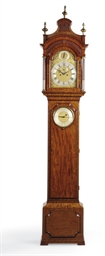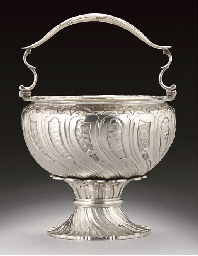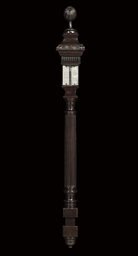AN UNUSUAL GEORGE I WALNUT OUTER DISPLAY CASE FOR A TABLE CLOCK ANONYMOUS, CIRCA 1720 The domed caddy superstructure capped with a rectangular upstand set on a cavetto moulded collar and veneered with crossbanded burr-walnut to top surface, flanked by four ball finials each applied onto a projecting plinth, over generous cavetto moulded cornice and hinged front panel centred with a 7 inch glazed dial aperture enclosing interior measuring 10.75 inches wide, 6.625 inches deep and 15 inches high, the sides with gilt brass carrying handles within crossbanded panels and the rear faced with a conforming arrangement of veneers, on cavetto moulded base incorporating bracket feet. 51cm (20ins) high, 35.5cm (14ins) wide, 25.5cm (10ins) deep. The current lot is unusual in that that it is clearly designed to display a 17th century table clock whilst serving as a protective case. Although outer protective cases for table clocks are known they are scarce and generally utilitarian in their form being mostly made of oak with iron fittings; one such case (for a clock by Joseph Windmills) is illustrated in Dawson, P.G.; Drover, C.B. and Parkes, D.W. Early English Clocks on page 476 (Plates 702/03). The present case, although clearly designed to house a 17th century table clock with 7 inch dial, would appear to stylistically date to around 1720. Indeed the unusual arrangement of finials are suggestive of the architectural influences of Vanbrugh and the bracket feet would indicate a date of around 1720. Furthermore the overall, slightly naïve, proportions of the case would also suggest that its origins are provincial perhaps North Country or even Irish. From this it may be reasonable to suggest that the owner of a late 17th century London-made table clock was looking to perhaps 'update' the appearance of his expensive clock, hence rather than re-case the movement and dial, he sought to have an outer case made thus retaining the clock itself in its original form. Notwithstanding the rarity of the present lot another outer case, this time designed with a glazed front applied with repousse mounts to display a clock by Nathaniel Hodges, is illustrated by Dawson, Drover and Parkes on page, 460 (Plate 677). The practice of housing clocks in purpose-made outer display cases would seem to be logical when considered alongside the contemporary approach to watches, which were more often than not pair or triple-cased.
AN UNUSUAL GEORGE I WALNUT OUTER DISPLAY CASE FOR A TABLE CLOCK ANONYMOUS, CIRCA 1720 The domed caddy superstructure capped with a rectangular upstand set on a cavetto moulded collar and veneered with crossbanded burr-walnut to top surface, flanked by four ball finials each applied onto a projecting plinth, over generous cavetto moulded cornice and hinged front panel centred with a 7 inch glazed dial aperture enclosing interior measuring 10.75 inches wide, 6.625 inches deep and 15 inches high, the sides with gilt brass carrying handles within crossbanded panels and the rear faced with a conforming arrangement of veneers, on cavetto moulded base incorporating bracket feet. 51cm (20ins) high, 35.5cm (14ins) wide, 25.5cm (10ins) deep. The current lot is unusual in that that it is clearly designed to display a 17th century table clock whilst serving as a protective case. Although outer protective cases for table clocks are known they are scarce and generally utilitarian in their form being mostly made of oak with iron fittings; one such case (for a clock by Joseph Windmills) is illustrated in Dawson, P.G.; Drover, C.B. and Parkes, D.W. Early English Clocks on page 476 (Plates 702/03). The present case, although clearly designed to house a 17th century table clock with 7 inch dial, would appear to stylistically date to around 1720. Indeed the unusual arrangement of finials are suggestive of the architectural influences of Vanbrugh and the bracket feet would indicate a date of around 1720. Furthermore the overall, slightly naïve, proportions of the case would also suggest that its origins are provincial perhaps North Country or even Irish. From this it may be reasonable to suggest that the owner of a late 17th century London-made table clock was looking to perhaps 'update' the appearance of his expensive clock, hence rather than re-case the movement and dial, he sought to have an outer case made thus retaining the clock itself in its original form. Notwithstanding the rarity of the present lot another outer case, this time designed with a glazed front applied with repousse mounts to display a clock by Nathaniel Hodges, is illustrated by Dawson, Drover and Parkes on page, 460 (Plate 677). The practice of housing clocks in purpose-made outer display cases would seem to be logical when considered alongside the contemporary approach to watches, which were more often than not pair or triple-cased.















Testen Sie LotSearch und seine Premium-Features 7 Tage - ohne Kosten!
Lassen Sie sich automatisch über neue Objekte in kommenden Auktionen benachrichtigen.
Suchauftrag anlegen